Anyone can go fast in a straight line, and practising jumps is fun. But improve your cornering ability and you’ll better your riding every time. We show you how to assess different turns over a variety of terrains, with the right techniques and tips to help you shred.
The three stages of every corner
Any corner you come across needs to be broken down into three stages – your entry, the actual turn and the exit. This is affected by the speed at which you hit the turn and any obstacles in the way, but the important thing is to spot your exit when on the way in, and set yourself up accordingly.
Your tyres simply don’t have enough grip to corner and brake at the same time, so you must control your speed before the corner. If keeping speed is what you want, then you should take a classic outside-inside-outside line to straighten out the turn and give yourself the best chance of grip.
1 Entry. By the time you get here you should have spotted your exit point, and have set yourself up at the right point in order to make the turn
2 The turn. With your exit point decided, you just need to make the bike get there. Don't use the brakes or the tyres will break loose, and keep your eyes on the exit point
3 Exit. As you get to the exit you must look ahead at your run out – when people mess up it's often because they're not looking ahead
Now that you understand basic cornering strategy, let’s look at different techniques required for specific turns.
How to ride switchbacks
Switchback turns are commonly found on goat paths and mountain trails where there’s steep terrain.
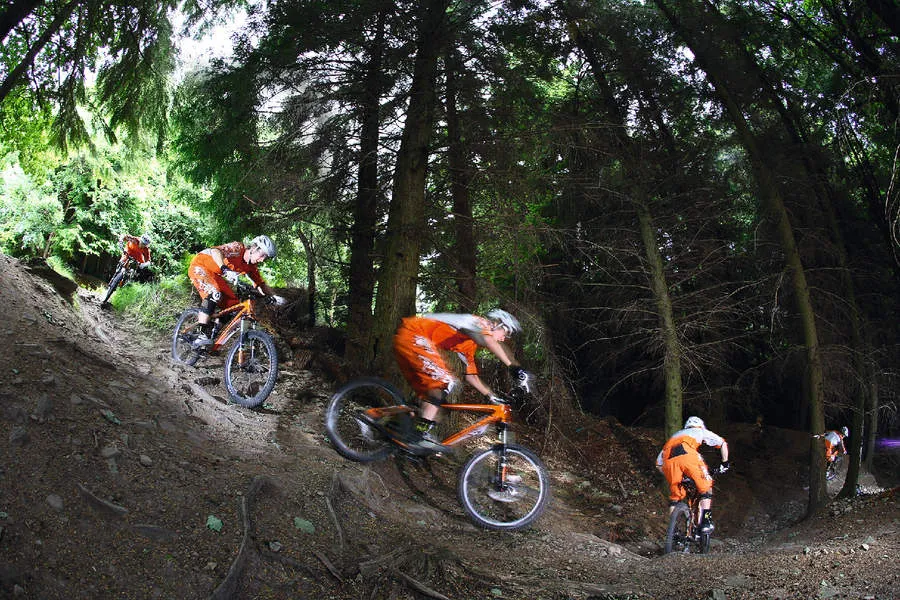
Entry,Corner,Exit: entry,corner,exit
There are two ways to tackle switchbacks – the planned and well set-up approach, or the more aggressive ‘throwing the bike into the turn’ method. Obviously the latter is only normally used when riding balls-out, or if you encounter a switchback unexpectedly.
- To get round a turn at speed you need to shift into a lower gear on approach – ready for exit – and briefly counter turn before turning sharply to initiate a slide.
- Allow the rear wheel to overtake the front and continue to counter steer.
- As soon as the bike is in line with where you want to be heading, get cranking for a smooth exit.
Or you could just slow down before the turn and use the three-step method.
1. Change into a lower gear on approach, ready for the exit

2. Get the rear end sliding and counter steer to keep moving

3. Get cranking to continue riding

How to master flat turns

Flat turns are one of the hardest turns to master because you have to rely on technique and trust in your tyres to manoeuvre them. Although it’s hard to get round them fast, it’s essential that you know how to deal with them because they’re the most common turns you’ll come across.
1 Weight the front wheel. Unlike bermed corners, there’s nothing for you to use as support – you have to provide the traction on your bike. The best place to have your body weight is on the front wheel – this drives it into the ground and gives maximum traction.
If the rear wheel breaks loose, it will regain traction as it follows the front wheel, but it’s important to learn this because sudden movements can force the bike to lose it rapidly.
2 Be prepared to dab your inside foot. On certain turns you may find it helpful to take your inside leg off the pedal to use as an outrigger – without actually planting your foot on the ground, you can get a bit more weight on the inside with the safety of being able to dab a foot to steady yourself if need be.
3 Maintain your form. As well as ensuring your weight stays over the front wheel, you need to stay loose and hold a good posture. You don’t want to be too high on the bike, nor sitting down. Hovering over the saddle is ideal – when it’s a turn that’s not too bumpy, you can perch on the end of the seat.
Keeping your elbows wide and your shoulders over the bars is great form and will allow you to react quickly when necessary – look at photos of downhill racer Sam Hill for an exaggerated example.
How to turn on berms

Berm is short for ‘banked turn’ and it’s one of the most fun things to ride. Many people think they’re there to make the turn easier, but they’re actually there to allow you to pick up speed around a turn. How much exactly depends on how hard you’re willing to try…
You can maximise your turn on a berm by looking at the best line to hit it. Some berms are placed in a manner for railing, and others, called catch berms, prevent slide and spit you off in the right direction.
On a fast berm, it helps to get your outside pedal down and lower your centre of gravity. Catch berms are best hit with your feet horizontal, so you can push into them.
To test your limits with a berm get to work on a few different types.
How to approach tricky off-camber turns

Off-camber turns are tricky because the bike naturally wants to decline away from the camber. Using a technique similar to the flat turn, you need to keep the front wheel weighted, and really push the weight into the bike to keep those tyres gripping as you carve a line.
Using your inside leg as an outrigger allows you to dab to save the front end, and also keeps the outside foot down, and most of the weight on that pedal, which really forces the tyre’s shoulder into the ground for grip. Leaning the outside knee on the top tube can help aid position too.
You’ll never get off-camber turns 100 per cent dialled because cambers are very unpredictable to ride. Shying away will mean you won’t make the turn, so stay committed and remember your three turning points.
How to tackle loose and busy turns
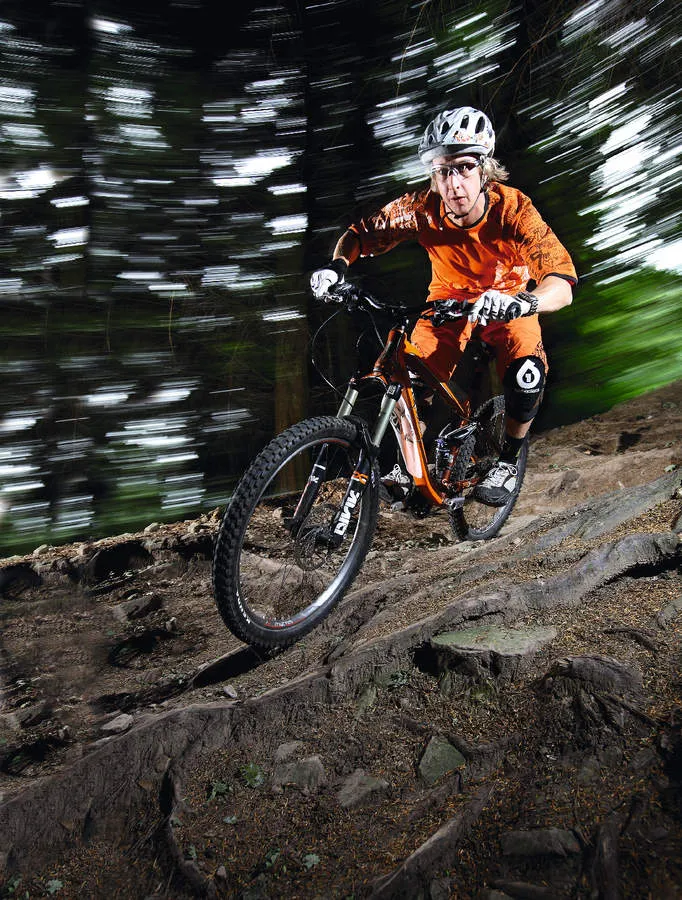
Turns with lots going on can be intimidating – you’ll want to shy away from any hazards that may make your front wheel slide out from under you. Roots, rubble, twigs and leaves all camouflage the ground you’re trying to ride, so you need to assess the terrain as you ride, thinking about what’s most likely to lose you traction.
- Keeping in mind your three points of entrance, turn and exit, try to be as direct as possible.
- During the turn itself you may have to use weighting or unweighting of the bike to keep traction.
- To unweight during a turn you have to search for ‘pools of safety’ – areas you can push into to load the suspension.
- As you come away from these the bike will spring up – allow it to do so and you’ll roll over most loose stuff that would have otherwise put you off.
One way to attack corners like this is to imagine you’re flying an X-wing and you’re aiming for the Death Star – you’re being fired upon but must stay on target at all costs. Keep focused on your exit point and aim to get there whatever happens. And stay loose!
How to rumble through root-infested turns

Roots can be the end-all of many a rider – they can be challenging to ride, especially on turns.
They’re best hit square on so the tyre can roll up and over them, but they’re almost certainly going to be crossing your path at an angle – so you must deal with them accordingly. Preloading the bike as you hit them is one of the best ways, because your tyres will keep traction for longer with no rider weight on the bike.
Another thing with roots is commitment – if you think you’re going to slide out, then you probably will, but if you attack them you’ll be fine. Even if the rear wheel skips out from under you, another root will generally stop it from sliding – so let it be and worry about the exit of your turn.
Of course with wet roots, there will be almost no traction, so keeping the most direct line will be the safest way through. As mentioned before, tyre pressure will help here – lower pressures allow the tyre to conform to the shape of the roots, thus making it less likely to slide away from them.
How to tackle rocky turns
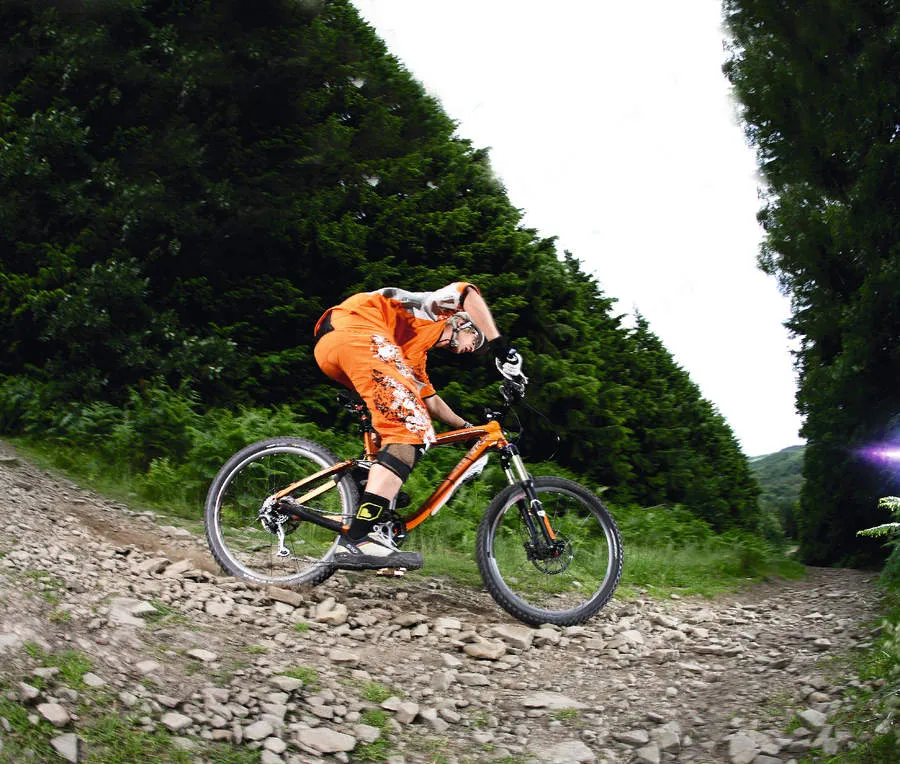
Don’t let yourself become too concerned by rocks in your pathway – it’s still a turn that requires an apex. If you avoid rocks you could be on for a bad line…
Rocks are hazardous like roots, but for the main reason that they’ll easily damage your bike. Stones can slash tyres, dent rims, prang chain rings, dent down tubes and, not to mention, make messy work of your toes – so you have to be on guard when tackling them.
Of course, you only see the worst rocks on downhill courses, but out in the mountains you’ll come up against plenty of loose rocks. These can be harder to ride than bigger fixed rocks, because they can move as you’re picking your way through them.
The best way to hit loose rocks is by attacking them – your wheels will slide around as they bounce off the rocks, but never fear, they will grip again as soon as they make contact with solid ground.
Your body has to be as loose as possible on the bike – still sticking to your entry, corner and exit points, but allowing the bike within reason to pilot itself underneath you – you’ll be amazed at what most bikes can roll over these days.
Nine tips for confident cornering
1. Use a short stem
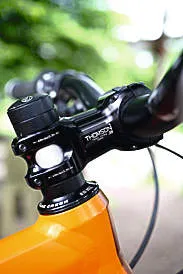
A long stem puts your weight too far over the front of the bike – if you lean forwards on a stem like this, the front wheel is likely to slide out. A short stem puts your weight nearer the centre of gravity of the bike, allowing you to move weight fore and aft – you’ll need to take off with your wrong foot (the one you don’t usually use when riding).
2. Keep your weight up front
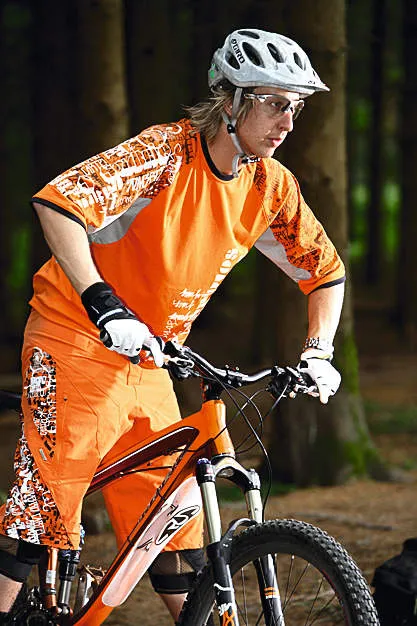
Keeping a good position is the key to weighting the front end of the bike successfully. Sam Hill’s exaggerated position is near-perfect for cornering duties – no wonder these happen to be his speciality.
3. Brake before the turn
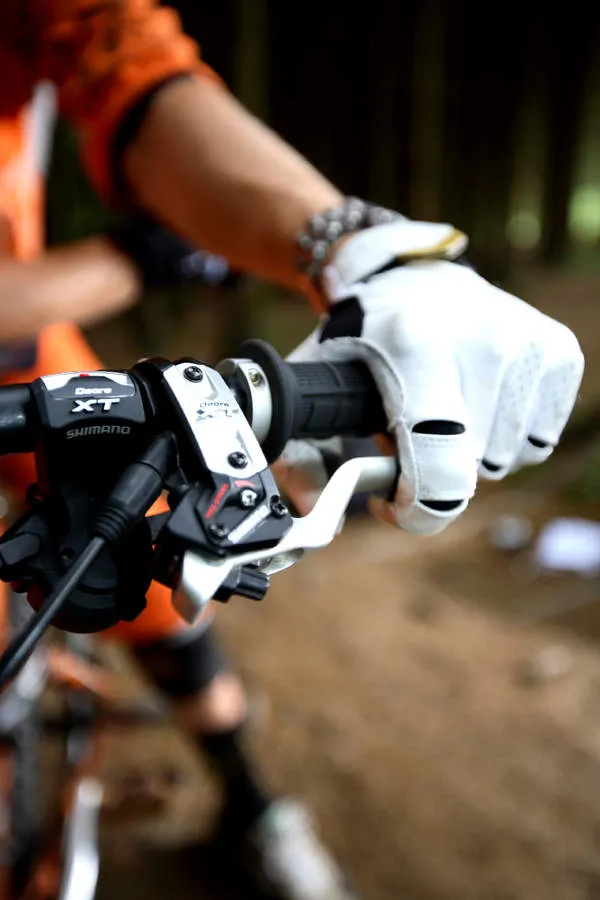
Get your braking done and wash off excess speed before the turn – the tyre just doesn’t have enough grip to turn and slow the bike at the same time.
4. Squaring a berm off
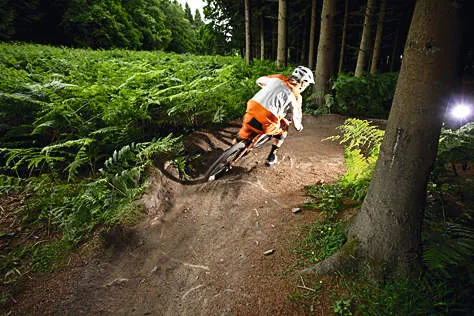
Squaring off berms is a great skill because you can use banks and roots to act as small berms.
Ride towards a berm at a fair pace and turn sharply, aiming to get the front wheel to hit the last third of the berm. The rear wheel will break loose and slide into the berm, and you’ll be propelled forwards.
5. Vary your tyre pressure

The harder the tyre, the less grip it will have, because less of it will be contacting the ground. If you go too soft, the tyre will lack support – find a few turns you can do well, whatever they are, and try various tyre pressures. It’s important to understand what the bike wants to do.
6. Tweak your suspension setup

To improve handling, make sure your suspension is set up well. If the rear end is too soft it’ll feel wallowy and the front will lack traction. If it’s too hard then the suspension won’t absorb bumps. If the front end is too soft, you’ll have too much weight on the front and you’ll lose traction.
7. Spend some time sessioning
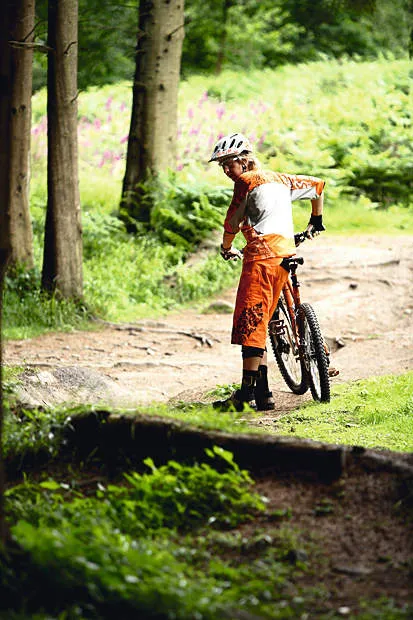
Sessioning is one of the best ways to perfect a corner – find one you struggle with and ride it, trying new methods – fast in, slow in, and various lines. You’ll soon find what works for you.
8. Prepare for the worst

Wet roots are about the worst thing a biker has to ride, so why not make the most of the enormous amount of wet weather we’re graced with and practice them. Be prepared to slam down though…
9. Make some video sessions

Watching yourself back on camera can show up mistakes you may not have been aware of. Also watch films of the best riders, and you’ll be able to glean tips on how to correct your riding.
Maintaining flow through turns can be the difference between a good rider and one who just thinks they’re good. When out freeriding and hitting bike parks, you’re going to hit all kinds of turns, so it’s time now to get down to the nitty gritty and get to work on cornering. Staying on board and in control through a gnarly turn will be its own reward.